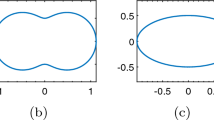Summary.
This paper analyzes the rate of convergence of the h-p version of the coupling of the finite element and boundary element method for transmission problems with a linear differential operator with variable coefficients in a bounded polyhedral domain \(\Omega_1\) and with constant coefficients in the exterior domain \(\Omega_2 = {\Bbb R}^3 \backslash \overline{\Omega}_1\). This procedure uses the variational formulation of the differential equation in \(\Omega_1\) and involves integral operators on the interface between \(\Omega_1\) and \(\Omega_2\). The finite elements are used to obtain approximate solutions of the differential equation in \(\Omega_1\) and the boundary elements are used to obtain approximate solutions of the integral equations. For given piecewise analytic data we show that the Galerkin solution of this coupling procedure converges exponentially fast in the energy norm if the h-p version is used both for finite elements and boundary elements.
Similar content being viewed by others
Author information
Authors and Affiliations
Additional information
Received February 10, 1996 / Revised version received April 4, 1997
Rights and permissions
About this article
Cite this article
Guo, B., Stephan, E. The h-p version of the coupling of finite element and boundary element methods for transmission problems in polyhedral domains. Numer. Math. 80, 87–107 (1998). https://doi.org/10.1007/s002110050361
Issue Date:
DOI: https://doi.org/10.1007/s002110050361




